Why do people reject this gold mine?
Wahyu Eka Styawan
The gold mine on Mount Tumpang Pitu (Sumberagung village, Pesanggaran sub-district, Banyuwangi district, East Java) has a long history. Its birth is recounted in Ika Ningtyas' book, Dua sisi Tumpang Pitu: kilau emas dan kerusakan lingkungan (Two sides of Tumpang Pitu: gold lustre and environmental damage, Tempo, 2019). In 1995, the firm PT Hakman Metalindo was granted a Mining Authorisation to explore an area of 62,586 hectares. This included the important conservation area, Meru Betiri National Park.
PT Hakman Metalindo operated the mine through three subsidiaries: PT Hakman Emas Metalindo (5,386 hectares), PT Hakman Platina Metalindo (25,930 hectares), and PT Hakman Perak Metalindo (25,120 hectares). The company began paving the way for a gold mine in the Meru Betiri area. However, its journey was short-lived. In 2006, the Banyuwangi district head made the bold decision to revoke the mining licence, thus ending their path to further gold mining endeavours.
The Banyuwangi authorities then transferred the licence to PT Indo Multi Cipta (IMC), which changed its name to PT Indo Multi Niaga (IMN) in 2006. A year later, PT IMN obtained an Exploration Mining Business Licence (IUP Exploration) covering 11,621.45 hectares in Pesanggaran District. However, PT IMN lacked the capital to conduct exploration, and the project was halted.
Then in 2012 PT IMN unexpectedly transferred its licence to PT Bumi Suksesindo (BSI), a subsidiary of PT Merdeka Copper Gold Tbk (MCG). This move triggered a dispute with Intrepid Mines, an Australian company that had previously been PT IMN's business partner. Intrepid felt cheated in the licence transfer process. The conflict finally ended after Intrepid sold its shares to Kendall Court Resources Investments Ltd.
Also in 2012, PT Bumi Suksesindo (BSI) quickly obtained a Production Operation Mining Business Permit (IUP OP) covering an area of 4,998 hectares, valid until 25 January 2030. Meanwhile, PT MCG also formed a subsidiary called PT Damai Suksesindo (DSI) to exploit Mount Tumpang Pitu. This time the area was larger: it included the villages of Sumberagung, Kandangan, and Sarongan. PT DSI then obtained an Exploration IUP covering an area of 6,623 hectares. As such, PT Merdeka Copper Gold (MCG) became the main controller of the mine at Mount Tumpang Pitu, supported by a network of national and international investors. The mine's future was strengthened after it was incorporated into the 2012-2032 Banyuwangi land-use plan (RTRW), which allocated 22,600 hectares for mining in Pesanggaran and Siliragung sub-districts.
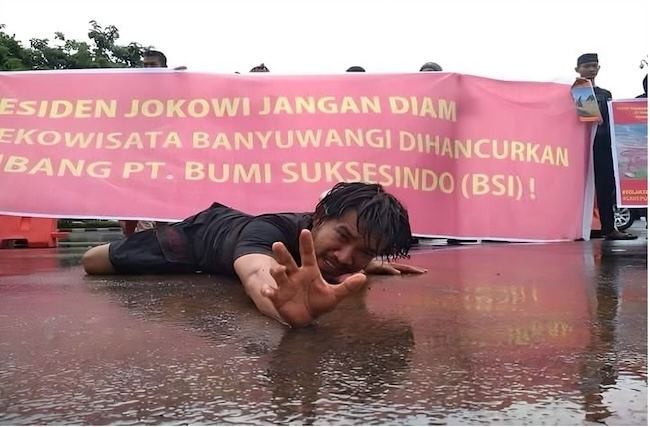
The Tumpang Pitu gold mine has gone through various phases of licence and ownership changes, from the hands of Hakman Metalindo to finally being controlled by PT Merdeka Copper Gold through its subsidiaries, PT BSI and PT DSI. The concession continues to undergo significant expansion, with the production licence valid until 2030. This long licensing journey reflects the way mining interests continue to flourish in the region, despite conflicts and policy changes involving the fate of natural resources and neighbouring communities.
Chronology of struggle
The story of resistance to the Tumpang Pitu gold mine is almost as long as the story of the mine itself. Here we refer to Ika Ningtyas' other book, Menambang emas di tanah bencana (Mining gold in the land of disaster, Resist Books, 2019). The first round of resistance took place from 2007-2012, the second from 2015-2018, and the third from 2019-2023 - all of which are interconnected.
The first round began when people became aware of the impact of mining exploration on their environment and livelihoods. The Anti-Mining Community Movement (Gerakan Masyarakat Anti Tambang, GERAMANG) began to take shape informally. It was initiated in 2007 by five local citizens concerned about the presence of PT Indo Multi Niaga (IMN). Although without any experience in organising large actions, they began to protest against company trucks carrying heavy equipment. This initiative became the first step towards a broader resistance.
In the second phase, from 2015 to 2017, tensions escalated as mining expansion continued. On 13 October 2015, peole managed to stop dozens of trucks carrying heavy equipment. This event sparked widespread support from neighbouring communities. Shortly afterwards, on 18 November 2015, more than 3,000 citizens took to the streets for a large demonstration in front of the PT Bumi Suksesindo (BSI) office. This became one of the largest demonstrations in Banyuwangi's socio-political history, bringing huge repercussions for the local community and government.
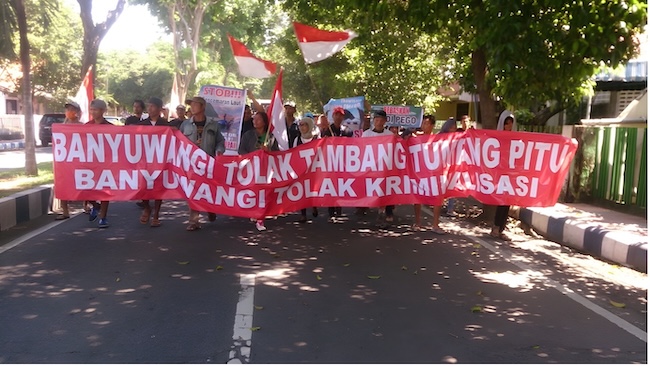
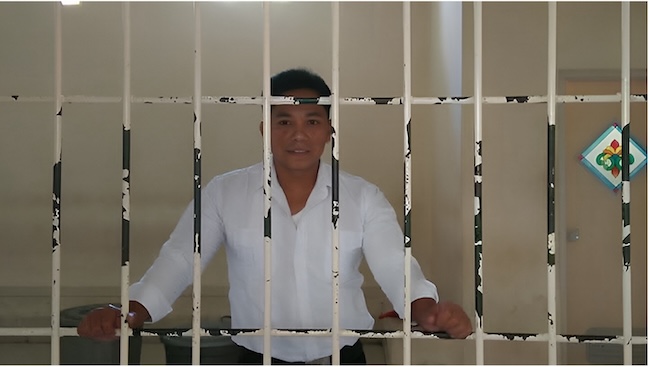
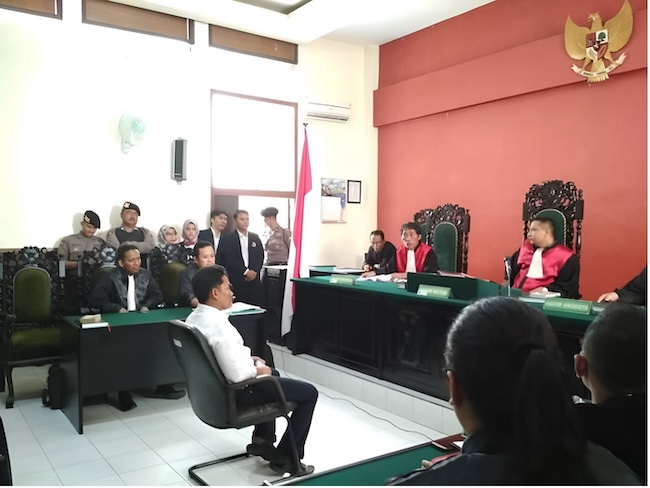
The year 2016 was a turning point in the resistance. A 'struggle coordination post' (posko perjuangan) was established in Pancer Hamlet, located on the coast at Sumberagung Village. This became the coordination centre for the entire action, but also the beginning of the criminalisation of the community.
Despite ongoing protests, PT BSI began gold mining operations on 1 December 2016. Budi Pego and three other villagers were arrested on charges of spreading communism, a controversial charge that was part of an attempt to silence the resistance. In April 2017, all four of them were named as suspects before being released to await proceedings. Budi Pego was then forcibly re-arrested. A year later, in January 2018, he was convicted, despite a lack of evidence. The verdict: 1 year in prison. However, an appeal to the Supreme Court (MA) led to Budi Pego's sentence being increased to 4 years in prison. By that time he had already been released. But strangely, no re-arrest or further detention followed the Supreme Court's decision.
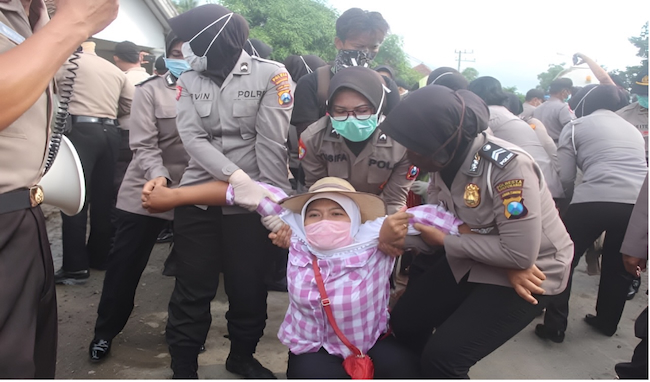
Then in the third round, from 2019 to 2023, symbolic actions became the main strategy for citizens to attract wider attention. In 2019, they held the ‘Cycle to Surabaya’ action, travelling hundreds of kilometres to protest directly to the East Java provincial government. However, repression against the movement became increasingly evident. During the rally, the office of Surabaya Legal Aid (LBH), which was providing legal assistance, was attacked by an unknown group.
The situation escalated on 27 March 2020, when citizens blocked the road to the site in protest against expansion of the mine. Major clashes ensued with security personnel.
Resistance flared up again in 2022. People began to focus on rejecting the mine’s expansion to Mount Salakan - neighbouring Mount Tumpang Pitu. They blocked company workers out to explore the area. Action also took the form of setting up a tent of struggle and solidarity, as a space to meet and a place to monitor the company's activities so they would not go up Mount Salakan. At the end of February 2023, there was a clash with the authorities as the company tried to forcefully enter Mount Salakan.
Not long after, on 24 March 2023, Budi Pego was re-arrested by the security forces. This time he was sent back in prison, on the pretext of serving the remaining 3 years of his sentence.
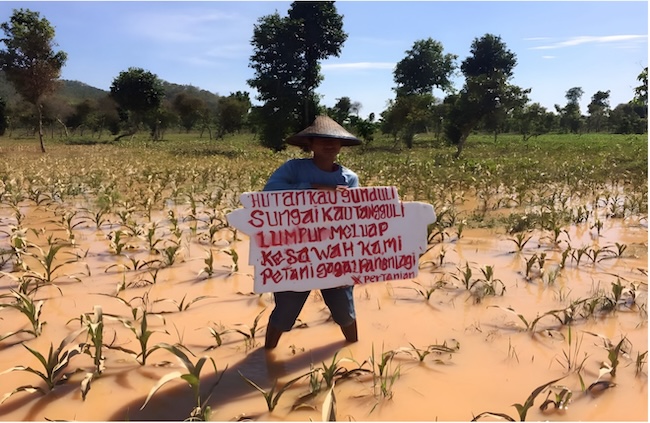
Peole’s resistance to Tumpang Pitu has grown from a local action to a large movement with widespread support. Despite the criminalisation of activists, repression by the authorities, and continual corporate pressure, their struggle has not stopped. One of their main issues remains agrarian conflict in Pancer Hamlet due to the granting of Mining Business Licence (IUP). This indicates that popular resistance to the Tumpang Pitu mine remains alive and continues to this day.
Mining impact
The rejection of the Mount Tumpang Pitu gold mine is not just a knee-jerk reaction, but a reflection of peoples’ deep sadness at the environmental and social impacts caused. Citizens of Sumberagung village, especially in Pancer Hamlet, have long witnessed how mining has changed their lives. What was promised as development and welfare has instead led to threats to ecosystems, livelihoods and agrarian justice.
Mount Tumpang Pitu used to be a protected forest that played an important role in maintaining ecological balance in coastal Banyuwangi. Gold mining has caused large-scale deforestation, destroyed water catchment areas, and increased the risk of disasters such as landslides and floods. Springs that have been a source of livelihood for farmers are slowly drying up. The Katakan River that previously irrigated rice fields is now being embanked by the mining company, causing water shortages in Pancer Hamlet. Disasters have become increasingly familiar to people living around the Tumpang Pitu concession, starting with successive floods from 2019-2021. The 2019 and 2020 protests were caused by flooding, as well as damaged roads.

Mining activities also disturb neighbouring villagers. One of them is blasting. In 2024 an enormous explosion in May 2024 caused buildings to vibrate in the tourist resort of Pulau Merah. Many tourists panicked and scattered to save themselves. Then in November 2024 blasting caused the whole of Mount Tumpang Pitu to collapse, creating an avalanche that went directly into the sea. The event reminded fishermen in Pancer Hamlet of the mud flood of 2016, where land-clearing activities by the mine caused flooding mixed with mud that eventually also entered the sea.
Economic damage
The Tumpang Pitu gold mine has also begun to have an economic impact on the lives of Sumberagung villagers. The development of the mine has gone hand in hand with a decline in their livelihoods. The majority of local residents depend on agriculture and fisheries, but both are now threatened by pollution and land conversion. One of the impacts they feel is the condition of the Katakan River. This has been the main source of irrigation for farmers, but is now being dug up by the company, causing many farms to lose their water supply. Wells have started to dry up, especially in the last two years, making life increasingly difficult.
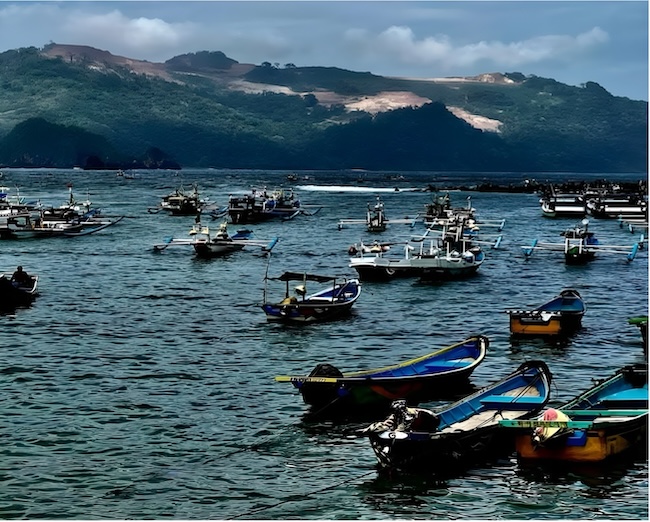
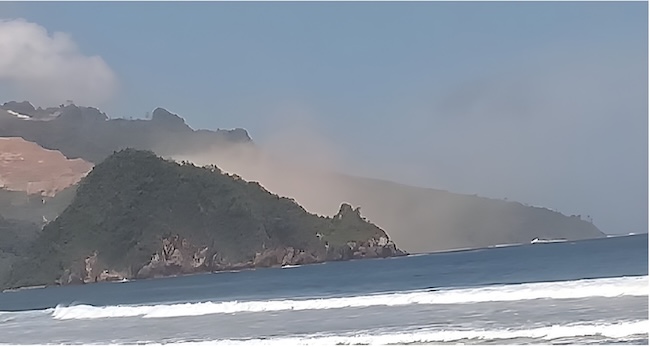
Farmers have begun to complain that their once fertile agricultural land is now shrinking and experiencing a water crisis. Although not always clearly enunciated, the strongest indications from dragon fruit farmers. The village is known as a large dragon fruit producer. It has been a mainstay of Sumberagung villagers for the past 15 years. Besides dragon fruit, there is also citrus. The farmers are now complaining that fruit production is not optimal, especially since the presence of the mine. One of their complaints of course relates to access to water, as well as the potential for flooding during the rainy season. They fear it fear when the Katakan River overflows.
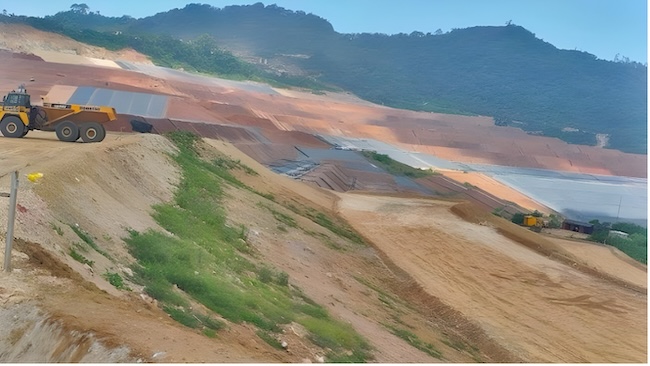
Even worse impacts are experienced by fishing folk, whose livelihoods depend on the sea. They have experienced a significant decrease in catches due to environmental pollution from mining waste. The fishers group in Pancer Hamlet revealed that since the mine began operating, they have had to go more than 5 miles offshore, from previously only 1-3 miles. Many fish have disappeared from the coastline due to the destruction of their habitat. Before the mine, in 2010 the total fish catch reached 10,280 tonnes. It has shrunk by about 1/4 since the mud flood of 2016 – to only 8,106 tonnes.
The tourism sector has also been badly affected. Sumberagung village used to be famous for its beautiful beaches. The waves were quite big, making it an alternative destination for foreign fishing enthusiasts who were tired of Bali. The tourist spot was called Pulau Merah (Red Island). The Banyuwangi District Government even included it as a major tourist destination in its Visit Banyuwangi programme, on a par with Mount Ijen.
But since the arrival of the mine, Pulau Merah has become increasingly deserted. Many resorts have gone out of business. Foreign tourists are reluctant to come. Although still visited by local tourists, Pulau Merah is no longer as beautiful as before. The sea water is sometimes murky. The scenery is disturbed by the loss of the Tumpang Pitu protected forest to mining activities. In addition, blasting activities by the mine have discouraged tourists.
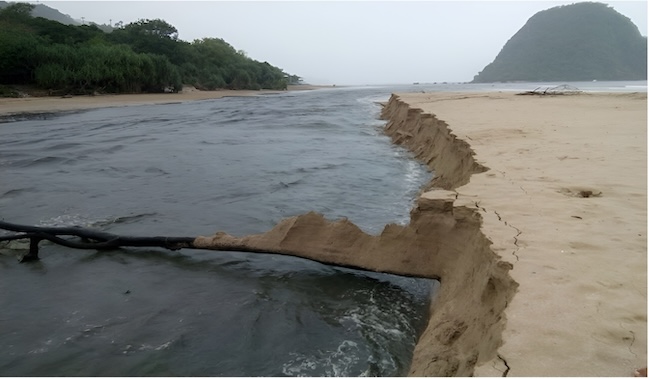
Farmers whose commodity production has declined, fishermen whose catches have declined and the tourism sector which has begun to fall off. In the end, the mine has become a problem for the entire local economy. Many people have been forced to migrate or to look for work as outsourcing labourers for the mine, as as casual day labourers. How ironic: they are forcibly losing the economic independence they had built up over many years.
Mining displaces people?
Mining not only brings environmental impacts, but also worsens the social conditions of residents. The bad luck experienced by people of Pancer Hamlet is an example. Even before the mining concession, they were already struggling to obtain land rights, because they were occupying land controlled by the state logging company (Perhutani). The hamlet of Pancer was originally a protected forest area directly adjacent to the sea.
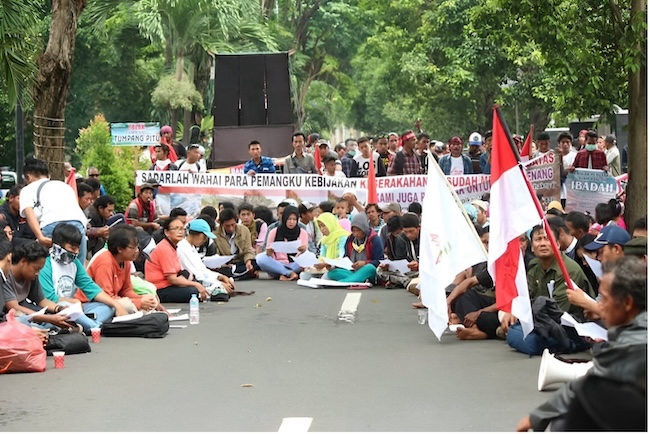
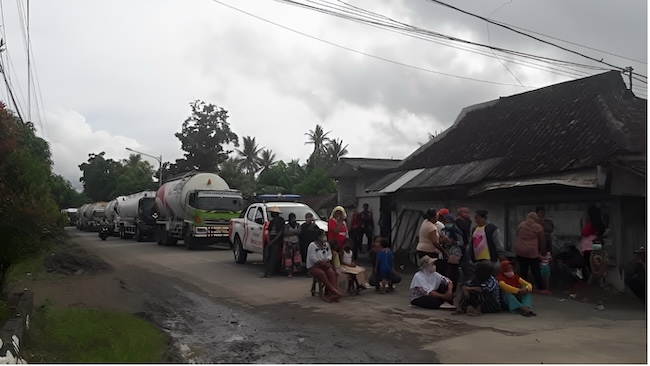
In 1994, an earthquake followed by a tsunami hit the Banyuwangi area. Before the tsunami, the population in Pancer had been relatively small, only around 1,000 people. The tsunami destroyed most of the settlement. Afterwards, the government relocated residents to safer areas, with the promise of land titles. Unfortunately, this promise was never realised. Residents were left with legal uncertainty over the land they occupied.
Over the past decade, the status of land in Pancer has become increasingly blurred as Perhutani began claiming the area as part of its territory. The burden on residents was further increased when mining concessions were issued on behalf of PT BSI and PT DSI. This certainly puts residents in the shadow of eviction. Without ever being involved in the decision to grant mining licences, they feel their land rights are being unilaterally seized.
The biggest threat for Pancer residents at this time is forced eviction. With the land still considered part of the Perhutani area, and overlapping with mining concessions, people have no legal certainty over their homes and land. At any moment, they could be forced off the land they have occupied for decades. In this uncertainty, they continue to fight to defend their rights to land and the environment that is increasingly threatened by the expansion of the mining industry, supported by the power of capital and government policies that do not favour the people.
People’s rejection of mining at Tumpang Pitu is not without foundation. What they have done until now is nothing less than a struggle to maintain their living space. They are fighting for the natural rights inherent in the environment, and for their right to a livelihood, and for agrarian justice. Mining is not just an economic activity. It is a tool of exploitation that destroys the social and ecological balance that local communities have long maintained. This exploitation not only destroys nature, but also destroys the lives of those who depend on the land and sea that are now in danger of disappearing.
Wahyu Eka Styawan (Wahyuwalhijatim@walhi.or.id) works for the environmental organisation WALHI in East Java.












